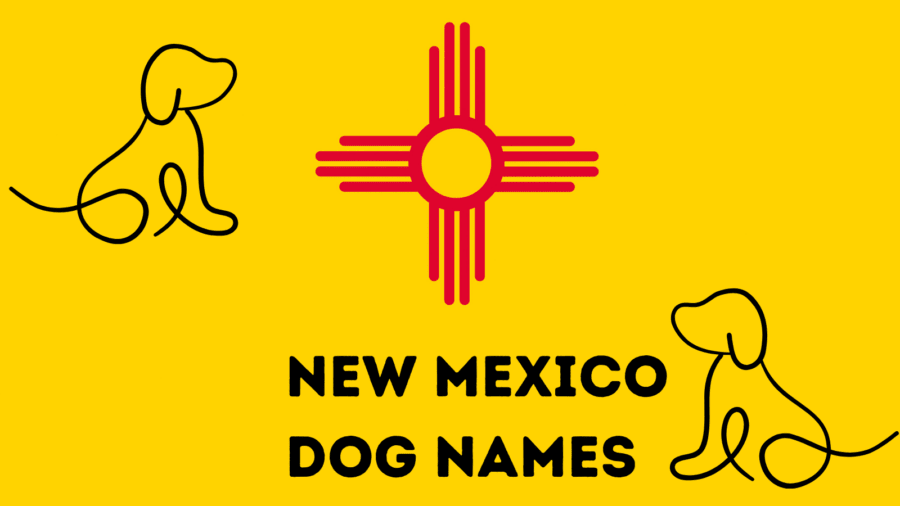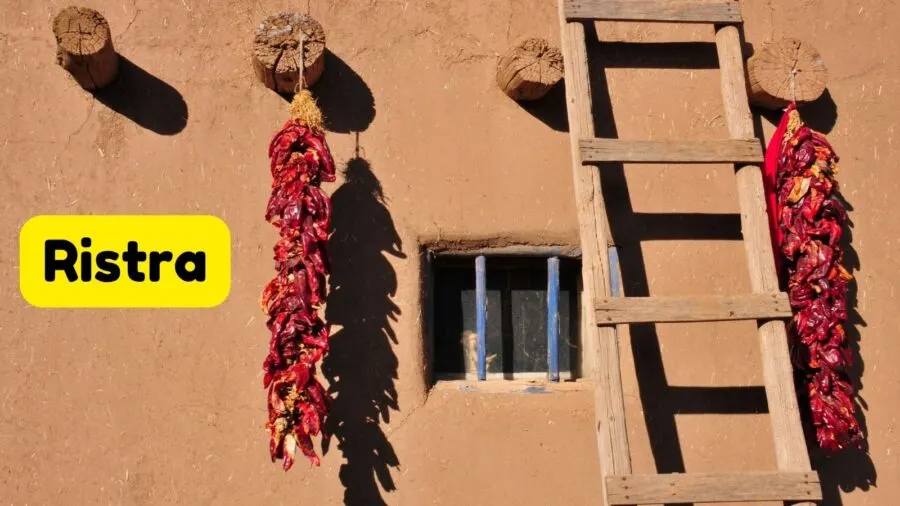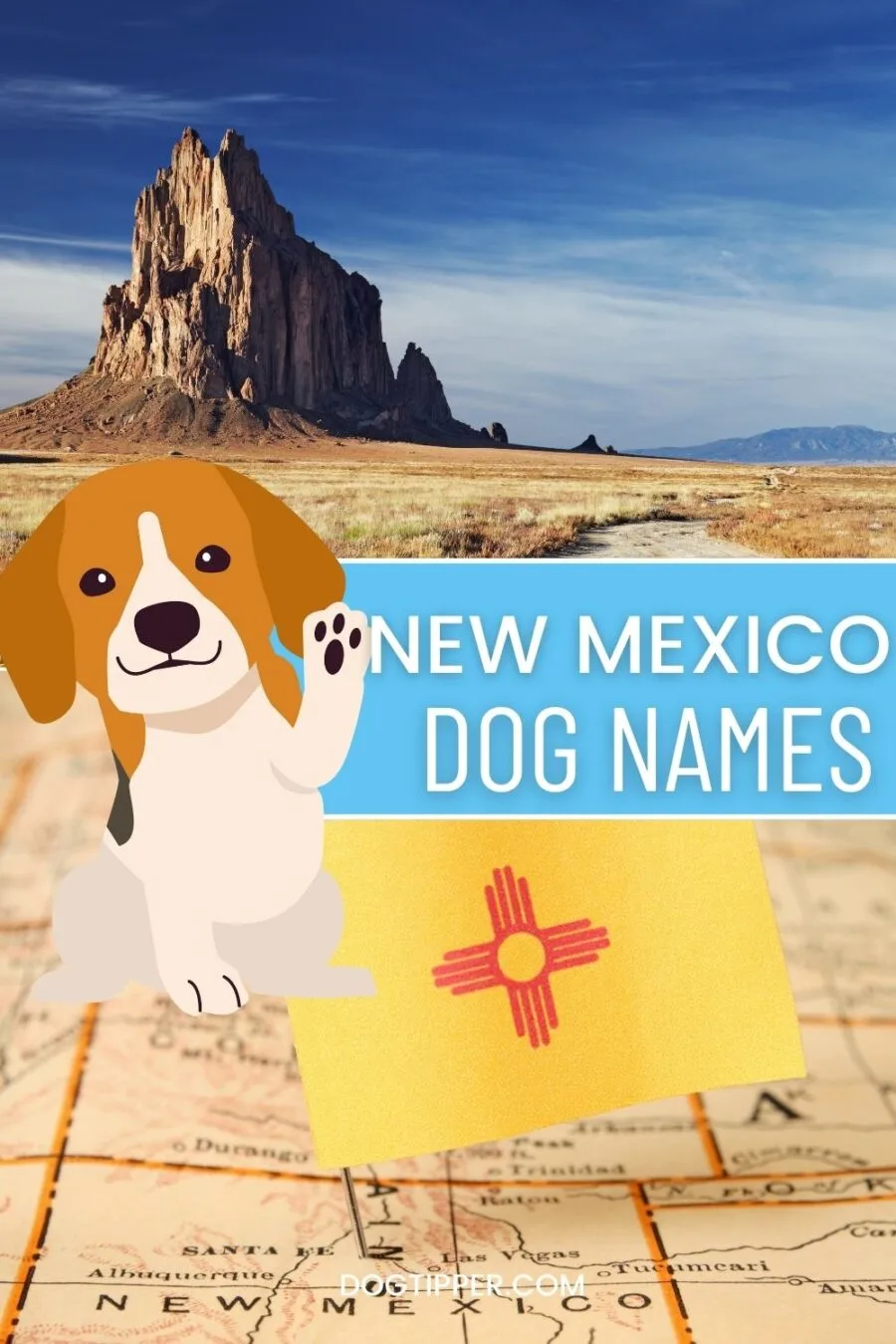New Mexico’s scenic landscapes, rich cultural heritage and diverse history serve as a wellspring of inspiration for dog lovers seeking unique and meaningful names. Let’s travel to the Land of Enchantment to explore a captivating collection of New Mexico dog names that will add a touch of Southwestern flair to your puppy’s identity.

Words Associated with New Mexico Culture
- Adobe – A type of sun-dried brick used to construct traditional Southwestern buildings.
- Casita – A small, typically adobe, house or cottage.
- Cactus – The iconic desert plant found throughout New Mexico’s arid landscapes.
- Chile – A staple ingredient in New Mexican cuisine, often referring to the spicy peppers used in dishes like green chile stew.
- Fiesta – Colorful and festive celebrations held in various towns and cities, often with parades, dances, and other cultural events.
- Gila – Named after the Gila River and Wilderness, a significant natural area in southwestern New Mexico.
- Kachina – Intricate Native American carved dolls representing spirits and deities.
- Kiva – A sacred underground chamber used for religious and ceremonial purposes by Pueblo people.
- Pueblo – Referring to the Native American tribes living in multi-storied, adobe villages.
- Ranchos – Referring to traditional rural communities or homesteads.

- Ristra – A string of dried chili peppers commonly used for decoration and culinary purposes.
- Rodeo – An event celebrating cowboy and ranching culture, featuring competitions like bull riding and roping.
- Zia – The Zia sun symbol, featured on the New Mexico state flag, representing the Zia Pueblo and the sacred number four.
Symbols of New Mexico
Biscochito: The official state cookie is a traditional anise-flavored cookie with cinnamon and sugar, often enjoyed during the holidays.
Chile: One of the state vegetables is the Chile Pepper; green chiles are particularly representative of New Mexico dishes.
Frijole: Frijoles (Pinto Beans) are the second official state vegetable, reflecting the importance of this crop in New Mexican cuisine.
Piñon: The state tree of New Mexico is the Piñon Pine (Pinus edulis), a hardy pine tree that produces piñon nuts, which are commonly used in local cuisine.
Roadrunner: The state bird of New Mexico is the Greater Roadrunner (Geococcyx californianus), known for its distinctive appearance and ability to run swiftly on the ground.
Turquoise: The state gem, a blue-green mineral that holds cultural significance for many Native American tribes in the region.
Ursus (americanus): The state animal of New Mexico is the Black Bear (Ursus americanus), which can be found in the state’s forests and wilderness areas.
Yucca: The state flower of New Mexico is the Yucca flower (Yucca glauca), a plant with tall flowering spikes and sword-shaped leaves.
Zia: The Zia sun is a Native American symbol representing the sun with four groups of four rays emanating from a central circle. The symbol is associated with the Zia Pueblo tribe and holds sacred significance to them.
Dog Names Based on City Names in New Mexico
- Alamogordo – “Fat Cottonwood” in Spanish, referring to the large cottonwood trees in the area.
- Albuquerque (or ‘querque would be an easy dog name) – Named after the Spanish Duke of Albuquerque, viceroy of New Spain at the time of its founding.
- Alcalde – “Mayor” or “Magistrate” in Spanish.
- Algodones – “Cotton” in Spanish, possibly referring to the cottonwood trees in the area.
- Angel Fire – Named after the nearby Angel Fire Resort, possibly inspired by the beauty of the area.
- Anthony – Named after a local rancher, Antonio (Anthony) of the Luna family.
- Artesia – Named for the many artesian wells drilled in the area for water.
- Aztec – Named after the Aztec Ruins National Monument located nearby.
- Bayard – Named after Thomas F. Bayard, a U.S. Senator from Delaware.
- Belen – “Bethlehem” in Spanish, named by Spanish settlers.
- Bernalillo – Named after the Spanish town of Bernalillo, the birthplace of the Conquistador Hernan Cortes.
- Bloomfield – Named after George H. Bloomfield, a surveyor who laid out the town.
- Bosque (Farms) – “Bosque” means “woods” or “forest” in Spanish.
- Brimhall – Named after a local family in the area.
- Capitan – Spanish for “captain” or “chief,” named after a nearby mountain, El Capitán.
- Carlsbad – Named after the famous Carlsbad Caverns located nearby.
- Carrizozo – Named after a nearby creek, “carrizo” means “reed” or “bulrush” in Spanish.
- Cedar Crest – Named after the abundance of cedar trees in the area.
- Chama – Spanish for “flame” or “fire.”
- Chamisal – Named for the chamisa plants that grow in the area.
- Chaparral – Named after the chaparral vegetation found in the region.
- Chimayo – Named after the nearby Chimayo River, of Tewa origin.
- Cimarron – Spanish for “wild” or “untamed,” possibly referring to the nearby Cimarron River.
- Cloudcroft – “Cloud Croft,” possibly referring to the clouds that form around the mountain.
- Clovis – Named after Clovis, a Frankish king from the 5th and 6th centuries.
- Cochiti (Pueblo) – Named after the Cochiti Pueblo Native American tribe.
- Corrales – “Corrals” in Spanish, named for the livestock corrals in the area.
- Cuba – Named after Cuba, the island nation in the Caribbean.
- Deming – Named after Mary Ann Deming Crocker, the wife of Charles Crocker, a railroad magnate.
- Dulce – Spanish for “sweet.”
- Espanola – Spanish for “Spanish,” the city was originally settled by Spanish colonists.
- Estancia – “Ranch” or “estate” in Spanish.
- Eunice – Named after the daughter of a Santa Fe Railroad executive.
- Farmington – Named for a settlement on a former farm.
- Flora Vista – “Flower View” in Spanish.
- Fort Sumner – Named after General Edwin Vose Sumner, a military commander.
- Gallup – Named after David L. Gallup, a paymaster for the Atlantic and Pacific Railroad.
- Glorieta – Spanish for “little glories” or “places of beauty.”
- Grants – Named after three Grant brothers who found uranium in the area.
- Hagerman – Named after James J. Hagerman, a railroad executive.
- Hatch – Named after General Edward Hatch, commander of the military district where the town was established.
- Hobbs – Named after James Hobbs, a homesteader and businessman.
- Isleta – Spanish for “small island,” named for the Isleta Pueblo Native American tribe.
- Jal – Named using the first letters of the last names of three daughters of a local rancher. (Our relatives used to live in this small town near the Texas border; it would be a fun three-letter name for your dog!)
- Jarales – Spanish for “reed beds.”
- Kirtland – Named after a colonel in the U.S. Army Corps of Engineers, Roy C. Kirtland.
- La Jara – “The Boxwood” in Spanish.
- La Luz – Spanish for “the light.”
- Laguna – Spanish for “lagoon” or “lake.”
- Lake Arthur – Named after Lake Arthur, a nearby body of water.
- Las Cruces – Spanish for “the crosses.”
- Las Vegas – Spanish for “the meadows.”
- Los Alamos – Spanish for “the cottonwoods.”
- Los Lunas – Spanish for “the moons.” A nice twist on Luna, always one of the most popular dog names.
- Loving – Named after Oliver Loving, a cattle rancher and trail driver.
- Lovington – Named after James H. Loving, a local rancher.
- Magdalena – Named after Magdalena Sanchez, the wife of a Santa Fe Railroad official.
- Melrose – Named after Melrose Abbey in Scotland.
- Mescalero – Named after the Mescalero Apache Native American tribe.
- Mesilla – Spanish for “small tableland.”
- Mesquite – Named after the mesquite tree.
- Nageezi – Named after the Nageezi Chapter of the Navajo Nation.
- Navajo – Named after the Navajo Native American tribe, who have a significant presence in the region.
- Pecos – Named after the Pecos River, derived from the Piro word “p’Èèku,” meaning “people of the earth.”
- Pena Blanca – Spanish for “white rock” or “white cliff.”
- Penasco – Spanish for “bighorn sheep.”
- Peralta – Named after the Spanish Peralta family, who were early landowners in the area.
- Placitas – Spanish for “small plazas” or “little places.”
- Ponderosa – Named after the Ponderosa pine trees abundant in the area.
- Portales – Spanish for “doorways” or “entrances.”
- Questa – “This” or “here” in New Mexican Spanish spoken by the residents of Questa; it is a combination of Spanish and Native American languages.
- Ramah – Named after the Biblical city of Ramah.
- Raton – Spanish for “mouse,” possibly referring to the abundant prairie dogs in the area.
- Rincon – Spanish for “corner” or “bend.”
- Roswell – The town synonymous with UFO sightings and one of the more popular New Mexico dog names.
- Ruidoso – Spanish for “noisy” or “ruidoso,” referring to the sound of the nearby Rio Ruidoso.
- San Ysidro – Named after Saint Isidore, the patron saint of farmers.
- Sanostee – Named after a Navajo word for “sunshine valley.”
- Santa Cruz – Spanish for “holy cross.”
- Santa Fe – Spanish for “holy faith.”
- Santa Rosa – Spanish for “holy rose.”
- Santa Teresa – Named after Saint Teresa of Ávila.
- Shiprock – Named after Shiprock, a prominent rock formation.
- Silver City – Named after the silver mining activities in the area.
- Socorro – Spanish for “help” or “aid,” referring to the assistance provided by local Native Americans to Spanish settlers.
- Sunland Park – Named for the nearby Sunland Park Racetrack and Casino.
- Taos – From the Taos Native American tribe, meaning “place of red willows.”
- Texico – Named after Texas and New Mexico, the two states it borders.
- Tijeras – Spanish for “scissors,” referring to the scissor-like appearance of the nearby rock formations.
- Timberon – Named after the combination of “timber” and “oxon,” referring to timber and cattle in the area (not to be confused with Tiberon which means shark in Spanish!)
- Tohatchi – Named after the Tohatchi Chapter of the Navajo Nation.
- Tome – Named after the Spanish town of Tomé.
- Torreon – Spanish for “big tower” or “fort.”
- Truth Or Consequences – Originally known as “Hot Springs,” renamed after the radio quiz show “Truth or Consequences” in 1950. A fun duo name for a pair of dogs!
- Tucumcari – Named after the nearby mountain, Tucumcari Mountain, which is believed to be derived from a Comanche word.
- Tularosa – Spanish for “red tule” or “red reeds.”
- Vadito – Spanish for “little ford.”
- Vado – Spanish for “ford” or “crossing.”
- Yatahey – Derived from the Navajo word “yáʼátʼééh,” which is a common greeting meaning “hello” or “goodbye.”
- Zuni – Named after the Zuni Native American tribe, who have a significant presence in the region.
Navajo Names
- Adahy – Lives in the woods.
- Ahanu – He laughs.
- Aiyana – Eternal blossom.
- Ashkii – Boy.
- Ayasha – Little one.
- Bidziil – He is strong.
- Chenoa – White dove.
- Chochmo – Mud mound.
- Dibe – Sheep.
- Doli – Bluebird.
- Hastiin – Man.
- Hialeah – Beautiful meadow.
- Hosh – Bear.
- Hoshkando – Blessing.
- Kai – Willow tree.
- Kaya – Pure.
- Leotie – Flower of the prairie.
- Maska – Strong.
- Nashoba – Wolf.
- Nita – Bear.
- Tazbah – Mirage.
- Tse – Rock.
- Tsula – Fox.
- Tuka – Sun.
- Tsuyi – Cottonwood.
- Unega – White.
- Yiska – Night has passed.
- Yuma – Son of the chief.
Keresan Names
Keresan is a language family spoken by several Pueblo tribes in New Mexico, including Acoma, Cochiti, Laguna, San Felipe, Santa Ana, Santo Domingo, and Zia Pueblos. Here are some Keresan baby names along with their meanings:
- Acoma – Name of a Pueblo tribe in New Mexico.
- Anasun – Sunflower.
- Kai – Willow tree.
- Kimo – Mountain lion.
- Luta – Red.
- Mika – Moon.
- Pekuna – Rain.
- Sina – Pearl.
- Tazhie – Bluebird.
- Tiamu – Brave.
- Tona – Buffalo.
- Tyasi – Star.
- Tzina – Wind.
- Yona – Bear.
Tanoan Names
Tanoan is a language family that includes several Native American tribes in New Mexico. Here are some Tanoan names along with their meanings:
- Tano – Sun.
- Tsuyi – Cottonwood.
- Tsira – Rain.
- Tyo – Sacred.
- Titona – Buffalo.
- Tsaitsai – Bluebird.
- Tsogwuu – Star.
- Tani – Rainbow.
- Taawi – Snow.
- Tha’wim – Mountain lion.
- Tewa – Coyote.
- Taye – Hawk.
- Tsuyya – Spring.
- Teewi – Willow.
- Tami – Moon.
- Tewa – Sunflower.
- Thunyaa – Bear.
- Tseena – Wind.
- Teyang – Deer.
- Tsaytsay – Bird.
Zuni Names
The Zuni people have their own distinct language, which is a linguistic isolate, not related to other indigenous languages in the region.
- Ahote – Restless one.
- Aponi – Butterfly.
- Haloke – Salmon.
- Honaw – Bear.
- Hutash – Fruitful.
- Kangee – Raven.
- Kasa – Dressed in furs.
- Kaya – My elder sibling.
- Kele – Sparrow.
- Koko – Night.
- Mahaska – White cloud.
- Miki – Little raccoon.
- Nahiossi – Tall.
- Niyol – Wind.
- Pahana – Lost white brother (a prophesized figure in Zuni beliefs).
- Payat – Healer.
- Sahkyo – Mink.
- Taima – Thunder.
- Tapco – Bead.
- Taza – Young.
- Tema – Earth.
- Thane – Chief.
- Tocho – Mountain lion.
- Tse – Rock.
- Tsela – Dawn.
- Tsiyi – Coyote.
- Tyee – Chief.
- Watkya – Bird.
Famous Names Associated with New Mexico
Georgia O’Keeffe – Renowned American artist known for her distinctive paintings of enlarged flowers, New York skyscrapers, and New Mexico landscapes.
Smokey Bear – The iconic mascot of the United States Forest Service, based on a real-life bear cub found in the Capitan Mountains of New Mexico in 1950.
Billy the Kid – Notorious Old West outlaw who was active in New Mexico during the late 1800s.
Dennis Hopper – American actor, director, and artist, known for his roles in films like Easy Rider and his contributions to the art world.
Harrison Schmitt – Former NASA astronaut and geologist who flew on the Apollo 17 mission and was the only geologist to walk on the moon.
Tony Hillerman – Acclaimed author known for his mystery novels set in the Southwestern United States, including many based in New Mexico.
Rudolfo Anaya – Renowned author and writer considered the father of Chicano literature, best known for his novel Bless Me, Ultima.
Demi Moore – Hollywood actress and film producer, born in Roswell, New Mexico.
More Dog Names You Might Like
325 Puerto Rican Dog Names for Your Sato!
180 Best Chihuahua Names for Your New Fur Baby!
Pin It to Remember these New Mexico Dog Names

- Review: Jimmy BX7 Pro Anti-Mite Vacuum Cleaner - December 16, 2024
- 🎉 GIVEAWAY: Lord of the Pets Portrait of Your Dog! - November 26, 2024
- Review: Lord of the Pets Portraits - November 17, 2024
